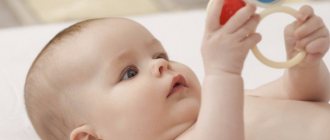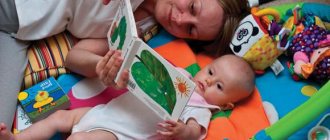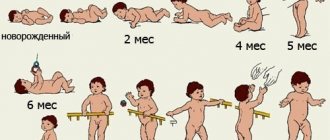It's finished! The first candle on the birthday cake - the baby is one year old... Our hero has noticeably matured, become independent and fully aware of what he wants. He is still learning about the world around him, and still needs his parents' closeness. A little person must be surrounded by care and love so that in the future he will develop into a strong personality, confident in his actions.
Read: Child development at 11 months.
Physical development of a child at 12 months.
In first-year children, the growth rate decreases noticeably. This is explained by the fact that the little one has become more active in movements, because the variety of food gives him the opportunity to receive more nutrients. In addition to the ability to walk, the baby continues to hone other actions: pushing, pulling, carrying various objects. He will notice the movements of his older brothers and sisters and copy them. For example, gymnastic exercises would involve bending forward until your head hits the floor. And in this manner, upside down, the mischievous person will look at what is happening, rejoicing in the fact that he made those around him laugh. As before, it is easier for a baby to climb up the stairs than to go down. He already knows the feeling of fear. This suggests that he now has a sense of height, and the instinct of self-preservation begins to work. We must continue to demonstrate to the child the rules of safe descent over and over again.
How to develop a child at 1 year old
To help your baby develop quickly and acquire more and more new skills, help him with this:
- Carry the child in your arms less, give him freedom of movement.
- Voice everything you see to your child and talk to him. Read books to your baby - this is so important for the development of a child’s speech.
- Play educational games: sorters, cubes, pyramids, lacing, etc. You can offer your child a simple role-playing game (for example, construction, racing, etc.). Finger games are good.
Child 12 months development and nutrition.
At the 12th month of life, the psychological side of a child’s life becomes noticeably more complicated. Unexpectedly for everyone, the baby may suddenly cry not from pain or fear, but from resentment. At home, the little one appears to be a fearless explorer, and among strangers, he demands that a loved one be nearby. He develops a fear of being abandoned by his mother. Therefore, you need to be very attentive to the baby and not give him reasons to worry.
A child at this age tries to influence adults to achieve his goals. Otherwise, he may throw a tantrum, fall to the floor, yell, scream and scream. At this moment, it is unacceptable to scold and punish a crying baby - he must be picked up and calmed down, rocked to sleep. It is necessary to sort out the situation only after the child has calmed down.
For another year after year, the emotional connection between mother and baby will remain. He will not be satisfied only with games, delicious food and communication with his peers. He needs his mother's hugs, tenderness and gentle hands like air. He must have confidence that he is the center of the universe for mom and dad, that he is their greatest treasure. Only in this way, feeling great love, will the baby recognize his own “I”, asserting his importance among people. One-year-old children develop a so-called “transitional object.” This is a thing or object that replaces a loved one who is currently absent. It is especially important for the baby to have this item at hand while falling asleep. It could be a soft toy or a mother’s shirt that retains her scent, or a diaper that is as warm as mom’s hands. It is important to remember that the “transitional object” should not become the child’s raison d’être. One should resort to his help only in those moments when the baby needs calm and peace of mind - going to bed, parting (even if for a short time) with parents, or when tears are shed due to a bruised knee. The rest of the time, the “amulet” should be removed, but at arm’s length from the child, so that he can press it to his chest at any time.
How to raise a 12 month old baby
Curiosity is a hallmark
Play role-playing games with your child more often, trying to play out the behavior patterns that you want to see in your everyday life. Show your child in the game how to behave, how to eat, how to sit on the potty. For him, information presented in such a playful form will be more understandable, accessible and powerful than just your words.
Teach your child to think and use available tools to solve problems. Did the ball roll under the sofa? Can't get it? Oh, let's try to push him with a spatula... Thus, the child gains life experience and learns to think and take an unconventional approach to solving assigned problems.
It is very important for a child to feel and know that he is loved and important to you. Take him in your arms more often, hug him, kiss him and stroke him. Don’t be afraid, you won’t spoil him or spoil him, but your affection, love and tenderness will help him grow into a harmonious and self-confident person.
What can a 12 month old baby do?
A 12 month old baby can:
- Transfer the spoon from one hand to the other while eating
- Draw water in the bathroom using available means
- Tear sheets of paper and plant leaves
- Take the beads over your head
- Splashing with arms and legs while bathing, trying to get out of the bath
- He walks almost confidently.
It is very interesting to observe how, from a passive being, a child turns into an active, mobile and very busy little person, capable of moving independently and satisfying his desires in understanding the world around him. The baby constantly “plays” with his own voice - sometimes he screams, sometimes he mutters something, imitating a conversation, sometimes he sings. Waking up early in the morning, the baby can talk to himself for a long time, making some sounds, until he wakes up his parents with his roulades.
Recipes for 12 month old babies
An example of a balanced weekly menu, which contains dishes that are not difficult to prepare, most of them are suitable for the whole family. After all, it is often not at all easy for a mother to manage everything.
| Days of the week | Breakfast | Dinner | Afternoon snack | Dinner |
| Monday | Oatmeal milk porridge with butter, white bread, tea. | Vermicelli soup with chicken broth, lazy cabbage rolls, compote. | Kefir, biscuits, 4 pieces. | Mashed potatoes, fish balls. |
| Tuesday | Macaroni with grated cheese, bread and butter, tea with milk. | Beetroot soup, vegetable stew with veal meatballs, compote. | Fruit puree. | Cottage cheese casserole. |
| Wednesday | Omelette with herbs, bread and butter, chicory drink with milk. | Rice soup, mashed potatoes with steamed minced chicken cutlets, rosehip drink. | Children's cottage cheese with fruit. | Vegetable stew with beef. |
| Thursday | Buckwheat milk porridge, bread with butter, tea. | Cauliflower soup, beef meatballs, compote. | Fruit juice, biscuits. | Beef liver casserole, tea. |
| Friday | Semolina milk porridge, bread with butter, tea. | Borscht, stewed potatoes with beef, compote. | Fruit yogurt. | Cauliflower puree with steamed cutlets. |
| Saturday | Millet porridge with milk, bread with butter, chicory drink with milk. | Vegetable soup, pasta with minced meat, rosehip drink. | Milk with a bun. | Pancakes with curd. |
| Sunday | 7-grain milk porridge, bread with butter, tea with milk. | Beef soup with vegetables, rice with minced meat and herbs. | Cottage cheese with fruit. | Vegetable puree with a piece of stewed fish. |
The menu, of course, is approximate; immediately before bedtime, the child additionally receives breast milk or formula; if necessary, the second breastfeeding is carried out early in the morning, before breakfast. Between breakfast and lunch, you can give your child an apple or pear, offer a fruit salad or a slice of banana.
Nutrition of a child at 12 months.
The diet of a one-year-old child is healthy and varied. Parents should definitely pay attention to foods that are not allowed on their child’s menu. These include the following products:
- Candy and chocolate
- Smoked and dried
- Sausages
- Spices and seasonings
- Tomatoes
What can a 12 month old baby do? By this time, the little one is already skillfully handling a spoon and is ready to start using a baby fork. To continue the development of chewing function, the child should be offered casseroles and steamed cutlets. Children's yoghurts and kefir will not hurt the digestive system. When offering bread, you need to make sure that the baby does not choke on the crumbs.
Sleeping mode
A one-year-old child may have two sleep patterns:
- The first involves maintaining the previous two-phase daytime sleep, which lasts an hour and a half. If a child needs this type of rest, then for the next four hours after it he remains active and in a cheerful state. And in the evening he goes to bed at approximately 22.00. This schedule includes feeding five times a day.
- There is another option, which involves a single nap during the day. But at the same time, the daily routine is undergoing changes. Typically, kids who like this particular schedule are classified as night owls. They get up no earlier than 8:00 in the morning, and during the day they prefer to sleep for two to three hours around one in the afternoon. At the same time, feeding five times a day becomes impossible, and the baby eats only four times a day. The advantages of this routine are that it closely resembles the conditions of a child’s stay in a preschool institution, and allows you to quickly adapt to attending kindergarten.
In order to understand which daytime rest schedule is best for your baby, you need to carefully observe him. You should switch to a single rest during the day in this case:
- During the onset of the first daytime sleep, the child remains alert and energetic, without any signs of drowsiness.
- Any attempts to put him to bed at this time cause protest and a negative reaction.
- The process of putting her to sleep takes so long that it forces her to significantly shift the timing of feeding, walking, and sleeping at night.
Games.
When choosing toys for a child who is one year old, it is necessary to focus on the development of visual memory, fine motor skills of the fingers, and speech development.
A child's development at 12 months is facilitated by a certain arsenal of building parts - these are arches, cones, pyramids, multi-colored cubes. The little one learns the basics of construction, and immediately destroys everything to the ground. During the creative process, fine motor skills of the hands and coordination of movements is honed. Various sorters are toys with holes where figures that correspond to the slots are placed. They give the baby an idea of shapes, helping to develop attention and perseverance.
Skills at one year of age
The possibilities of motor activity at 12 months are that the baby is already good at:
- stand without support or support;
- walk with the help of an adult using one or both arms, and sometimes independently;
- actively crawl, with the exception of children who immediately begin to walk, which is also normal;
- move by crawling up and down stairs;
- walk up the stairs, putting one leg on the other with the help of an adult;
- perform squats, rising to your feet from this position;
- climb onto a chair, crib or sofa, and go down to the floor.
The development of a child at the 12th month of life also manifests itself in play; it is considered normal if the baby has learned to do the following:
- disassemble and assemble the pyramid;
- put small toys in containers, open the lids and close them;
- play with cubes, making a tower out of them;
- pick up small objects using two fingers;
- in play, imitating adults, care for, feed and put toys to bed;
- Observe the actions of other children and repeat them.
Social development and the sphere of emotions are considered normal by the age of one year, in the case when the child can:
- express your feelings: hug loved ones, kiss them;
- show joy while playing with adults and other children, as well as new toys;
- recognize relatives and rejoice at their arrival;
- look at photographs of your loved ones and recognize them, and point with your finger;
- become wary or cry at the sight of a stranger;
- look at books with bright pictures and point at the images at the request of an adult;
- try to dance or sing along to familiar music;
- imitate the behavior of an adult and copy his facial expressions.
An indication of the correct speech development of a child at the age of one year is the assessment of active speech and understanding of what others are saying. The child should be able to:
- speak about 10 words in your own language;
- answer the question “who is this”;
- imitate animal sounds: barking, meowing, bleating;
- try to repeat more complex words after adults;
- repeat sounds and words after other children;
- fulfill the request: “bring it, give it, open it”;
- understand when they say “you can’t”;
- point to an object at the request of an adult;
- learn your name and respond to it.
The baby’s everyday skills should also develop; usually at 12 months he can:
- bite off pieces of food and chew them;
- drink from a glass or mug (bottle, sippy cup) completely independently, holding it with two handles;
- start trying to eat with a spoon, some children even know how to prick food with a fork;
- help an adult dress himself for a walk;
- make it clear that his pants are wet, especially if the parents do not use diapers, and many children at this age already know how to ask to go to the potty;
- hold out the handles for washing under the tap and try to wipe them with a towel.
A child's daily routine at 12 months.
Significant changes occur in the routine of a one-year-old baby. The period of wakefulness increases to 5 hours. This becomes possible due to the increase in the efficiency of his nervous system.
If the baby goes to bed on a schedule for several days, sleeps for several hours, and the next time only falls asleep at night, then the parents are lucky. Because adapting to a new “sleep” routine usually takes several weeks or even months.
Read: Child development at 2 years old.
Child development chart up to 1 year.
Routine – sleep and nutrition
Parents of many one-year-old children are faced with a change in routine. We have to do this because now it becomes difficult to put the child to bed during the day at the same time, so daytime sleep has to be pushed back. This is how “night owls” manifest themselves, who wake up in the morning at 9–10 o’clock and go to bed at 14–15 o’clock in the afternoon. Thus, it turns out that such children begin to sleep during the day once for 2–3 hours, from about 14 to 17 hours, and their night sleep begins only at 22 hours or even later.
In this regard, it is necessary to accustom the baby to a different diet. If the child switches to one long nap during the day, then feeding him five times will not work. Such kids eat 4 times, for example: breakfast at 9.00, lunch at 13.00, afternoon snack at 17.00 and dinner at 21.00.
If your baby’s routine has not changed, then everything remains the same. (see child at 11 months)
How to help your baby develop
Continue to carry your baby in your arms periodically. (see “holding” a child at 10 months.) A child’s development at one year old is still aimed at improving speech and fine motor skills, so continue activities that develop these functions. (see child at 10 and 11 months.) The most important skill that your baby is now acquiring is walking. No matter how much you want your child to start walking, it is important that he is ready for this. If the baby has mastered crawling and moves easily, then you can encourage him to start walking, but there is no need to wean him off crawling. To do this: Place your baby's favorite toys at an accessible height. As soon as you notice that the baby has stood up and is reaching for the object, move it a little further from the child so that the baby takes a few steps towards the target. Don’t rush your baby; the musculoskeletal system gradually gets used to the new loads. Increase the distance gradually. When the child learns to take several steps on his own in a row from support to support, create for him several such goals in the form of toys. Let the baby move from one support to another: from a chair to a crib, from a crib to a chair. Very often, a child is prevented from taking the first step by a feeling of uncertainty and fear of losing balance. Give your child a toy for balance, step back a couple of steps and ask him to bring you the object. For many children, this is enough to dare to walk on their own. When you go for a walk with your child, draw the child’s attention to other children who are already walking. Someone else's example is contagious. Do not overuse walkers, they can create incorrect posture (FOR and CONS of walkers). It is better to use rolling toys or reins. Support your baby by the forearms or hands, but not by the armpits. When the baby can take several steps on his own, you can belay him from behind, supporting him by the hood. Now try to use the stroller less. Falls are an important part of learning to walk. Do not rush to him immediately after falling; let the baby try to get up on his own. Help if the child really cannot get up or hits himself and starts crying. If you have somewhere to walk on grass, on sand, or just on the ground, then it will be useful to let your child walk barefoot. A baby should be taught to walk on a hard floor only in special children's shoes. The reason is that when walking, certain muscle groups in the foot are tensed, which only happens when moving on natural surfaces (earth, sand, pebbles). When a child walks on a hard floor, the foot is relaxed or not fully tense, which leads to various disorders in the gait and ankle. It should be noted that the first shoes should not be just slippers or elegant sandals, but orthopedic correct shoes. It is advisable that they be lace-up and with a high back - for stable fixation of the ankle and with a 5 mm heel - to prevent flat feet. Of course, you don’t need to keep your child in shoes all the time, but when the baby learns to walk, put them on.
Read the article 10 ways to teach a child to walk
Games
Play story games with your children: everything you saw on a walk can be played out at home with the help of toys, for example: you watched a truck unload a body. You can repeat this at home with a children's car and cubes. Or arrange fairy tale performances for your child using a children's finger theater or matryoshka dolls in the form of fairy tale characters.
It's time to rebuild your relationship with your child. Organize your games and activities with him so that they take place together, but at the same time you allow the baby to independently do what he knows. There must be sincere trust between you and the child, only in this case the baby will be able to learn from you and develop fully.
← 11 month










